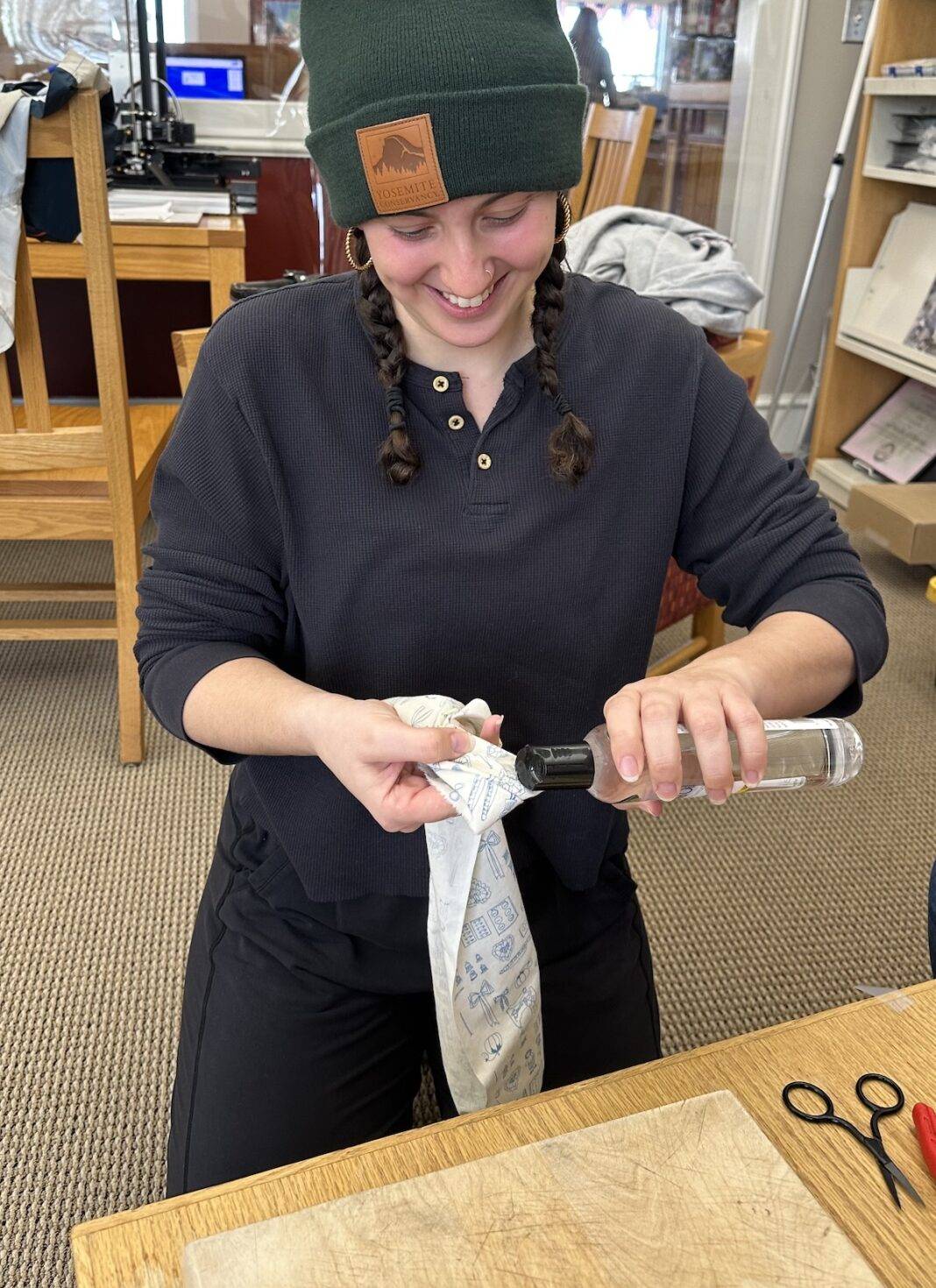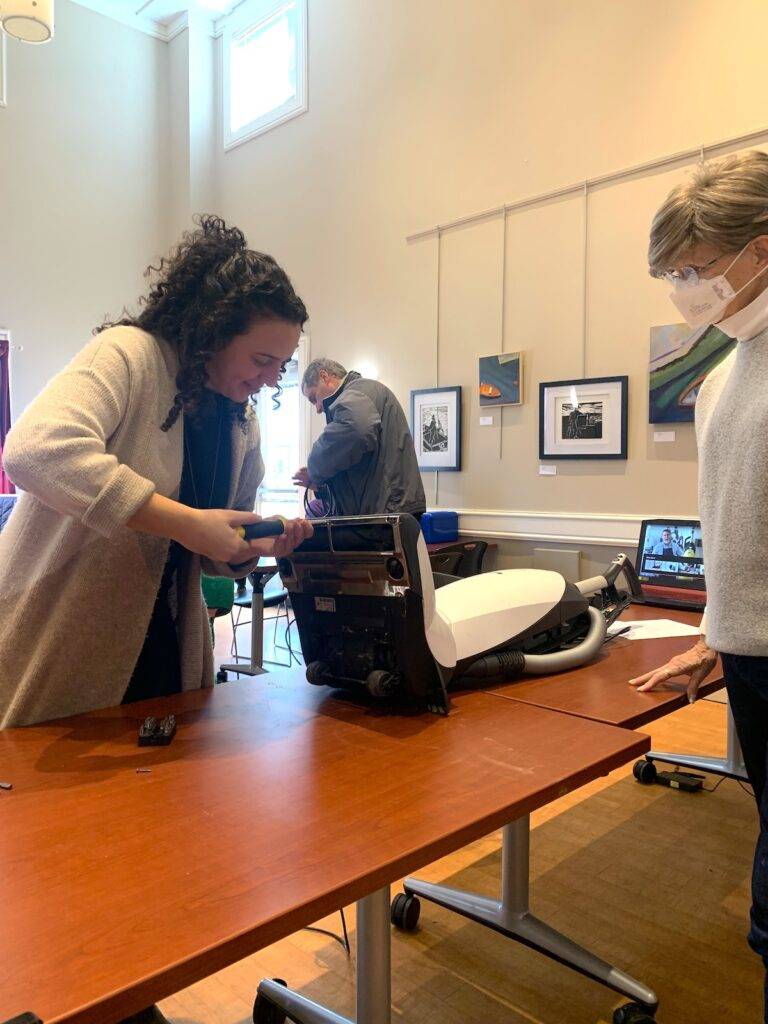Getting more life out of your stuff is good for the planet.
In this era of convenience and instant gratification, it seems too easy to justify throwing something away. Maybe there’s an old sweatshirt with a tear in the sleeve, or a coffee maker that’s on the fritz. You attempt to dampen your sentimentality to these items (that you never even knew you had) as you prepare to take your sweatshirt to the thrift shop and your Mr. Coffee to the dump. But then you see a serendipitously placed poster suggesting a “Fix It Clinic” at the Oak Bluffs library, and you change your game plan.
In my case, the Fix It Clinics at the Oak Bluffs library, which are held the first Saturday of every month, were not just a convenient discovery, but an illuminating one. I had no idea what to expect from this public workshop — all I knew was that one of my favorite pairs of pants had a hole in one knee that wasn’t getting any smaller. I grabbed my holey slacks and was about to head to the library when my mom spoke up. She had gotten wind of my plans and wanted me to bring along her dried-out cutting boards so I could season them properly.



The small room where the clinic took place was outfitted with a sewing machine, a variety of tools, a couple laptops, and a whole bunch of willing helpers. Hannah Burbidge, programming coordinator for the Oak Bluffs library, said she knew way back before COVID that she wanted to create more sustainable programming for the library and for the town. “I was looking into different things that people do like this — some folks do mending circles, but the Fix It Clinic is more of a national program where your community organization can be registered as a clinic if you meet certain marks,” Burbidge explained.
Burbidge said the clinics help folks get a better understanding of their consumption habits, and importantly, their waste habits. By opting to repair and reuse an item, you not only maximize its value, but you keep it out of the waste stream.
Burbidge said the clinics help folks get a better understanding of their consumption habits, and importantly, their waste habits. By opting to repair and reuse an item, you not only maximize its value, but you keep it out of the waste stream. “It’s totally a win-win,” she said. “It’s really cool because you don’t have to have a lot of really knowledgeable people, you just have to have people who are willing to look at the problem and figure it out. You can just look up a YouTube video and fix so many broken things on your own.”

At the prior clinic, Burbidge said a woman brought in a vacuum that was turning on but wasn’t functioning. She and Burbidge looked up a tutorial video, cleaned out the edges near the brush roller, and the vacuum was good as new. Burbidge said her main missing piece of practical knowledge when she started the program was mending clothes. But experienced seamstress Lory Reilly offered to volunteer and help folks out with their sewing and patching. Reilly hemmed some jeans for a very pleased participant, she fixed her own duvet cover, and even repaired Burbidge’s raincoat for her dog. “I didn’t want to go out and buy another $40 raincoat for my dog when it was such an easy fix,” Burbidge said.


As for my Fix It items, the library provided me with a soft cloth to apply the oil on my mother’s cutting boards. My clinic companions let me know at the outset that I probably should have sanded down the boards before oiling them (I’ll know for next time), but I figured mom would still be overjoyed her boards no longer looked like the end of a dock in the summer heat.
Kris Kiehn was mending her favorite pair of shorts at the clinic — the hook button had come off, and she was looking to sew it back on. “I’ve been wanting to fix it, but I needed a seam ripper and the right color thread,” Kiehn explained. Kiehn also had some cutting board wisdom to impart, suggesting that I let them sit and reapply the oil on layers, almost like applying paint or a varnish. “You’re forming multiple layers so the wood doesn’t splinter and break. Once that board cracks, there’s no going back,” Kiehn said.



Then there were my pants. The hole was so small as to be almost unnoticeable, but had I not brought the pants into the clinic, the hole would have grown, and I would have had an exposed kneecap in no time flat. Reilly suggested buying some patch material that’s roughly the same color as my pants and using that — she used some thread that was a very similar color as a temporary solution.
Before I departed, Burbidge summed up one core element of the clinic with a simple and well-used proverb: “If you give a man a fish, you feed him for a day. If you teach a man to fish, you feed him for a lifetime.”
The next Fix It Clinic is March 4 from 1 pm to 3:30. Here’s more info.



Wow. It makes me so happy to see initiatives like this. What an innovative resourceful and AWESOME idea and person.